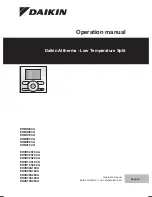
T35 TRANSFORMER PROTECTION SYSTEM – INSTRUCTION MANUAL
9-1
T35 Transformer Protection System
Chapter 9: Theory of operation
Theory of operation
This chapter outlines advanced information on operation.
9.1 Directional principle
9.1.1 Current directional protection
For better security, the T35 uses the current directional protection principle to dynamically supervise the main current
differential function. The directional principle is in effect permanently for low differential currents (region 1 in the Two
Regions of Differential Characteristic figure) and is switched on dynamically for large differential currents (region 2 in the
same figure) by the saturation detector (see the Saturation Detector section) upon detecting CT saturation.
The directional principle responds to a relative direction of the fault currents. This means that a reference signal, such as
transformer voltage, is not required. The directional principle declares that
•
If all of the fault currents flow in one direction, the fault is internal, or
•
If at least one fault current flows in an opposite direction compared with the sum of the remaining currents, the fault is
external
The directional principle is implemented in two stages.
First, based on the magnitude of a given current, it is determined whether the current is a fault current. If so, its relative
phase relation has to be considered. The angle check must not be initiated for the load currents as the direction is out of
the transformer even during internal faults. The auxiliary comparator of this stage applies an adaptable threshold. The
threshold is a fraction of the restraining current. The current from a particular feeder is used for bus directional
comparison if its magnitude is greater than 0.2 × I
restraint
or it is greater than 2 times its CT rating.
Second, for the selected fault currents, the phase angle between a given current and the sum of all the remaining currents
is checked. The sum of all the remaining currents is the differential current less the current under consideration. Therefore,
for each, say the pth, current to be considered, the angle between the I
p
and I
D
- I
p
phasors is to be checked.
Ideally, during external faults, the said angle is close to 180° (as shown); and close to 0 degrees during internal faults.
Содержание T35
Страница 9: ...TABLE OF CONTENTS T35 TRANSFORMER PROTECTION SYSTEM INSTRUCTION MANUAL ix ABBREVIATIONS INDEX ...
Страница 10: ...x T35 TRANSFORMER PROTECTION SYSTEM INSTRUCTION MANUAL TABLE OF CONTENTS ...
Страница 14: ...1 4 T35 TRANSFORMER PROTECTION SYSTEM INSTRUCTION MANUAL FOR FURTHER ASSISTANCE CHAPTER 1 INTRODUCTION 1 ...
Страница 202: ...4 88 T35 TRANSFORMER PROTECTION SYSTEM INSTRUCTION MANUAL FLEXLOGIC DESIGN USING ENGINEER CHAPTER 4 INTERFACES 4 ...
Страница 472: ...5 270 T35 TRANSFORMER PROTECTION SYSTEM INSTRUCTION MANUAL TESTING CHAPTER 5 SETTINGS 5 ...
Страница 500: ...6 28 T35 TRANSFORMER PROTECTION SYSTEM INSTRUCTION MANUAL PRODUCT INFORMATION CHAPTER 6 ACTUAL VALUES 6 ...
Страница 514: ...7 14 T35 TRANSFORMER PROTECTION SYSTEM INSTRUCTION MANUAL TARGETS MENU CHAPTER 7 COMMANDS AND TARGETS 7 ...
Страница 580: ...A 16 T35 TRANSFORMER PROTECTION SYSTEM INSTRUCTION MANUAL FLEXANALOG ITEMS APPENDIX A FLEXANALOG OPERANDS A ...
Страница 588: ...C 6 T35 TRANSFORMER PROTECTION SYSTEM INSTRUCTION MANUAL COMMAND LINE INTERFACE APPENDIX C COMMAND LINE INTERFACE C ...
Страница 596: ...iv T35 TRANSFORMER PROTECTION SYSTEM INSTRUCTION MANUAL ABBREVIATIONS ...
















































